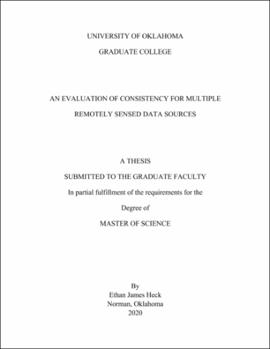| dc.description.abstract | Archive continuation through succeeding satellite missions is highly important in preserving and creating deep repositories of information for Earth observation. However, with varying spectral and spatial resolution, it can be a challenge to harmoniously continue archives through different platforms such as planned with MODIS and VIIRS. I first evaluate the consistency between two collections of the Moderate Resolution Imaging Spectroradiometer (MODIS) data to highlight discrepancies that can exist between dataset even when the data is collected from the same sensor. Three different MODIS products are investigated to determine the extent that improvements made to C6 influence the overall trend results for time series between 2001 and 2017. I focus on these three products specifically, both to allow for a comparison of vegetation index products—NDVI (Normalized Difference Vegetation Index) and EVI (Enhanced Vegetation Index) from MOD13C1, and NDVI and EVI calculated based on surface reflectance from MCD43C4—and also to gain an understanding of the improvements on an entirely different product from the same sensor, namely Land Surface Temperature (LST) from MOD11C2. Next, I evaluate the consistency of MODIS and the Visible Infrared Imaging Radiometer Suite (VIIRS) to contribute to the knowledge of how seamlessly VIIRS can be used in the continuation of the MODIS archive. The MYD09GA and MCD43A4 products from MODIS, as well as the VNP09GA and VNP43IA4 products from VIIRS are used to carry out the analysis. In addition to surface reflectance, I also evaluate NDVI and the tasseled cap transformations of brightness, greenness, and wetness. I have conducted this analysis on the north island of New Zealand because the multiple land covers and their fragmented tendencies are a very good representation of how well the sensors correlate in potentially complex land surface scenarios. | en_US |
